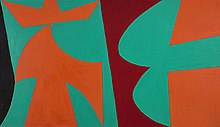This is an old revision of this page, as edited by Coldcreation (talk | contribs) at 13:39, 15 November 2014 (Fixing typo raised by BracketBot). The present address (URL) is a permanent link to this revision, which may differ significantly from the current revision.
Revision as of 13:39, 15 November 2014 by Coldcreation (talk | contribs) (Fixing typo raised by BracketBot)(diff) ← Previous revision | Latest revision (diff) | Newer revision → (diff)
Hard-edge painting is painting in which abrupt transitions are found between color areas. Color areas are often of one unvarying color. The Hard-edge painting style is related to Geometric abstraction, Op Art, Post-painterly Abstraction, and Color Field painting.
History of the term
The term was coined by writer, curator and Los Angeles Times art critic Jules Langsner, along with Peter Selz, in 1959, to describe the work of painters from California, who, in their reaction to the more painterly or gestural forms of Abstract expressionism, adopted a knowingly impersonal paint application and delineated areas of color with particular sharpness and clarity. This approach to abstract painting became widespread in the 1960s, though California was its creative center.
Other, earlier, movements, or styles have also contained the quality of hard-edgedness, for instance the Precisionists also displayed this quality to a great degree in their work. Hard-edge can be seen to be associated with one or more school of painting, but is also a generally descriptive term, for these qualities found in any painting. Hard-edged painting can be both figurative or nonrepresentational.
In the late 1950s, Langsner and Peter Selz, then professor at the Claremont Colleges, observed a common link among the recent work of John McLaughlin (1898–1976), Lorser Feitelson (1898-1978), Karl Benjamin (1925-2012), Frederick Hammersley (1919–2009) and Feitelson's wife Helen Lundeberg (1908-1999). The group of seven gathered at the Feitelson's home to discuss a group exhibition of this nonfigurative painting style. Curated by Langsner, Four Abstract Classicists opened at the Los Angeles County Museum of Art in 1959. Helen Lundeberg was not included in the exhibit. These painters were featured in a touring exhibition during 2008 called "The Birth of the Cool" in California museums along with midcentury design, music and film.
Exhibition
Four Abstract Classicists was subtitled California Hard-edge by British art critic and curator Lawrence Alloway when it traveled to England and Ireland. The term came into broader use after Alloway used it to describe contemporary American geometric abstract painting featuring "economy of form," "fullness of color," "neatness of surface," and the nonrelational arrangement of forms on the canvas.
In 1964, a second major hard-edge exhibition curated by Jules Langsner was held at the Pavilion Gallery in Balboa, CA (also known as the Newport Pavilion) with the cooperation of the Ankrum Gallery, Esther Robles Gallery, Felix Landau Gallery, Ferus Gallery and Heritage Gallery of Los Angeles. This was called, simply, California Hard-edge painting. Included in this show were Florence Arnold, John Barbour, Larry Bell, Karl Benjamin, John Coplans, Lorser Feitelson, Frederick Hammersley, June Harwood, Helen Lundeberg, John McLaughlin, and Dorothy Waldman.
In 2000, Tobey C. Moss curated Four Abstract Classicists Plus One at her gallery in Los Angeles. The exhibit again featured John McLaughlin, Feitelson, Hammersley, and Benjamin, and added Lundeberg as the fifth of the original Hard-edge painters. In 2003, Louis Stern Fine Arts showed a retrospective exhibition for Lorser Feitelson entitled Lorser Feitelson and the invention of Hard-edge painting, 1945-1965. The same year, NOHO MODERN showed the works of June Harwood in an exhibition entitled June Harwood: Hard-edge painting Revisited, 1959-1969. Art critic Dave Hickey solidified the place of these 6 artists in: The Los Angeles School: Karl Benjamin, Lorser Feitelson, Frederick Hammersley, June Harwood, Helen Lundeberg, and John McLaughlin. The exhibition was held at the Ben Maltz Gallery of the Otis Art Institute in Los Angeles in 2004-2005.
The style
This style of hard-edge geometric abstraction recalls the earlier work of Kasimir Malevich, Wassily Kandinsky, Theo van Doesburg, and Piet Mondrian. Other artists associated with Hard-edge painting include Herb Aach, Josef Albers, Richard Anuszkiewicz, Max Bill, Ilya Bolotowsky, Ralph Coburn, Nassos Daphnis, Ronald Davis, Gene Davis, Robyn Denny, Howard Mehring, Burgoyne Diller, Peter Halley, Al Held, Robert Indiana, Ellsworth Kelly, Günther C. Kirchberger, Alexander Liberman, Agnes Martin, Kenneth Noland, Ad Reinhardt, Deborah Remington, Bridget Riley, Ludwig Sander, David Simpson, Leon Polk Smith, Julian Stanczak, Jeffrey Steele, Frank Stella, Myron Stout, Leo Valledor, Victor Vasarely, Charmion von Wiegand, Neil Williams, Larry Zox and Barbro Östlihn.
See also
- Modern art
- Abstract art
- Formalism (art)
- Shaped canvas
- Minimal art
- Abstract Imagists
- Lyrical Abstraction
- Abstract expressionism
- Concrete art
References
- Tate Glossary, Hard-edge painting retrieved August 8, 2009
- retrieved June 2, 2010
- It was in 1959 that Langsner and art historian Peter Selz originated the phrase "hard-edge painting" to describe the colors, shapes and style of abstract expressionist painting on the West Coast and in particular the works by John McLaughlin
- Karl Benjamin’s Colorful Resurgence, accessed October 21, 2007
- "Birth of the Cool: California Art, Design, and Culture at Midcentury", accessed July 21, 2008
Sources
- NOHO MODERN (2003) June Harwood: Hard-Edge Painting Revisited, 1959-1969 exhibition catalogue,
- Louis Stern Fine Arts (2003) Lorser Feitelson and the Invention of Hard-Edge Painting, 1945-1965 exhibition catalogue,
- Moss, Tobey C. (2000). Four Abstract Classicists Plus One exhibition catalogue,
- Nittve, et al. (1998). Sunshine & Noir: Art in LA 1960-1997. Louisiana Museum of Modern Art.
External links
- Guggenheim collection online
- Hard-edge Painting - Art Movement and Style Overview on Art Story Foundation
- British artist Robyn Denny
| Abstract art | |
|---|---|
| Geometric abstraction | |
| Lyrical abstraction | |
| Predecessors | |
| Minimal art | |
|---|---|
| Artists (list) | |
| Forms | |
